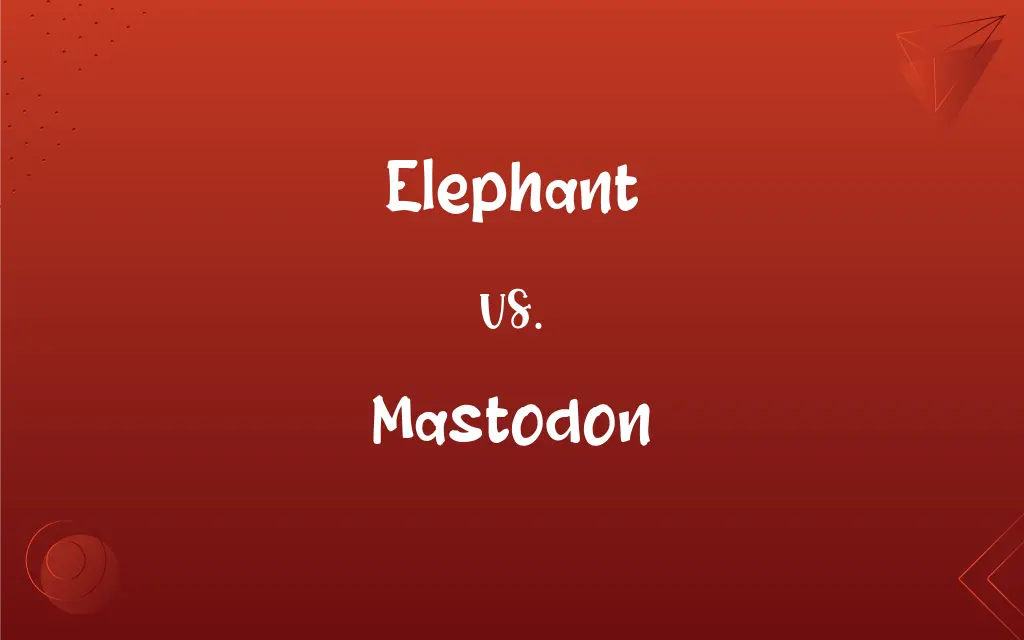Elephant vs. Mastodon: What's the Difference?
Edited by Janet White || By Harlon Moss || Published on December 20, 2023
Elephants are modern, large mammals with curved tusks and trunks, while mastodons were prehistoric relatives with straighter tusks and distinct tooth structure.

Key Differences
Elephants are currently existing mammals known for their large ears and versatile trunks, whereas mastodons, now extinct, were prehistoric relatives with smaller ears and less flexible trunks.
The tusks of elephants are generally curved and used in various tasks, while mastodons had straighter and thicker tusks, possibly adapted for different environmental challenges.
In terms of size, modern elephants, both African and Asian species, are generally larger compared to mastodons, which were smaller but robust.
Elephants have a more diverse diet, including grasses and trees, whereas mastodons primarily fed on shrubs and leaves, as evidenced by their tooth structure.
Elephants play a crucial role in their ecosystems as keystone species, while mastodons, during their time, had a similar impact on their prehistoric environments.
ADVERTISEMENT
Comparison Chart
Existence
Currently living
Extinct
Ear Size
Larger ears (especially African elephants)
Smaller ears
Tusk Shape
Generally curved
Straighter and thicker
Size
Larger
Smaller but robust
Diet
Grasses, trees, fruits
Shrubs, leaves
ADVERTISEMENT
Elephant and Mastodon Definitions
Elephant
A large mammal with a long trunk and big ears.
We saw a majestic elephant on our safari.
Mastodon
Known for its distinct molar tooth structure.
Scientists studied the mastodon's teeth to understand its diet.
Elephant
A key species in maintaining ecological balance.
The elephant helps maintain the savanna's biodiversity.
Mastodon
An extinct mammal resembling an elephant.
The museum displayed a mastodon's fossil.
Elephant
A symbol of strength and wisdom in many cultures.
The elephant in the parade was adorned with colorful fabrics.
Mastodon
Once a dominant herbivore of the Pleistocene.
The mastodon played a crucial role in its ecosystem.
Elephant
An animal known for its exceptional memory.
The elephant remembered the way back to its watering hole.
Mastodon
A prehistoric creature with straight tusks.
The mastodon's tusks were used to depict its lifestyle in a documentary.
Elephant
A species threatened by habitat loss and poaching.
Conservationists are working hard to protect the elephant.
Mastodon
A symbol of ancient wildlife and biodiversity.
The mastodon is often mentioned in discussions about prehistoric life.
Elephant
Any of several very large herbivorous mammals of the family Elephantidae native to Africa, South Asia, and Southeast Asia, having thick, almost hairless skin, a long, flexible, prehensile trunk, upper incisors forming long curved tusks of ivory, and, in the African species, large fan-shaped ears.
Mastodon
Any of several very large, extinct proboscidian mammals of the family Mammutidae of the Miocene, Pliocene, and Pleistocene Epochs, resembling elephants but having molar teeth of a different structure.
Elephant
Any of various extinct animals of the family Elephantidae.
Mastodon
Extinct elephant-like mammal of the genus †Mammut that flourished worldwide from Miocene through Pleistocene times; differs from elephants and mammoths in the form of the molar teeth.
Elephant
A mammal of the order Proboscidea, having a trunk, and two large ivory tusks jutting from the upper jaw.
Mastodon
(figurative) Anything big or clunky.
Elephant
(in particular) Any member of the subfamily Elephantinae not also of the genera Mammuthus and Primelephas.
Mastodon
An extinct genus of mammals closely allied to the elephant, but having less complex molar teeth, and often a pair of lower, as well as upper, tusks, which are incisor teeth. The species were mostly larger than elephants, and their remains occur in nearly all parts of the world in deposits ranging from Miocene to late Quaternary time.
Elephant
(figuratively) Anything huge and ponderous.
Mastodon
Extinct elephant-like mammal that flourished worldwide from Miocene through Pleistocene times; differ from mammoths in the form of the molar teeth
Elephant
Synonym of elephant paper
Elephant
Used when counting to add length, so that each count takes about one second
Let's play hide and seek. I'll count. One elephant, two elephant, three elephant...
Elephant
Ivory.
Elephant
(xiangqi) A xiangqi piece, that is moved two points diagonally, may not jump over intervening pieces and may not cross the river.
Elephant
A mammal of the order Proboscidia and family Elephantidae, of which two living species, Elephas maximus (formerly Elephas Indicus) and Loxodonta Africana (formerly E. Africanus), and several fossil species, are known. They have five toes, a long proboscis or trunk, and two large ivory tusks proceeding from the extremity of the upper jaw, and curving upwards. The molar teeth are large and have transverse folds. Elephants are the largest land animals now existing. The elephant is classed as a pachyderm.
Elephant
Ivory; the tusk of the elephant.
Elephant
Five-toed pachyderm
Elephant
The symbol of the Republican Party; introduced in cartoons by Thomas Nast in 1874
FAQs
Are elephants endangered?
Yes, mainly due to poaching and habitat loss.
What do elephants eat?
A vegetarian diet, including leaves, fruits, and bark.
What is the social structure of elephants?
Matriarchal, led by a female.
What habitats do elephants live in?
Various, including savannas, forests, and grasslands.
What caused the extinction of mastodons?
Likely due to climate change and human hunting.
When did mastodons live?
During the Pleistocene epoch, millions of years ago.
What were the characteristics of mastodons?
Similar to elephants but with straighter tusks.
Do elephants have good memory?
Yes, they are known for their exceptional memory.
What are the main threats to elephants?
Poaching for ivory and habitat destruction.
How long do elephants live?
Up to 60-70 years in the wild.
Where were mastodons found?
Across North America and parts of Eurasia.
Did mastodons live in herds?
Evidence suggests they had a social structure, possibly in herds.
What is unique about an elephant's trunk?
It's highly versatile, used for breathing, smelling, touching, and grasping.
What do mastodon fossils tell us?
They provide insights into prehistoric ecosystems and climates.
How do scientists study mastodons?
Through fossils, including bones and teeth.
What is the significance of mastodon discoveries?
They help understand the diversity and evolution of ancient mammals.
How do elephants communicate?
Through vocalizations, body language, and infrasound.
How many species of elephants are there?
Three: African bush elephant, African forest elephant, and Asian elephant.
Were mastodons hunted by early humans?
Yes, evidence suggests they were.
How were mastodons different from mammoths?
Mastodons were smaller with different tooth structure.
About Author
Written by
Harlon MossHarlon is a seasoned quality moderator and accomplished content writer for Difference Wiki. An alumnus of the prestigious University of California, he earned his degree in Computer Science. Leveraging his academic background, Harlon brings a meticulous and informed perspective to his work, ensuring content accuracy and excellence.
Edited by
Janet WhiteJanet White has been an esteemed writer and blogger for Difference Wiki. Holding a Master's degree in Science and Medical Journalism from the prestigious Boston University, she has consistently demonstrated her expertise and passion for her field. When she's not immersed in her work, Janet relishes her time exercising, delving into a good book, and cherishing moments with friends and family.

































































